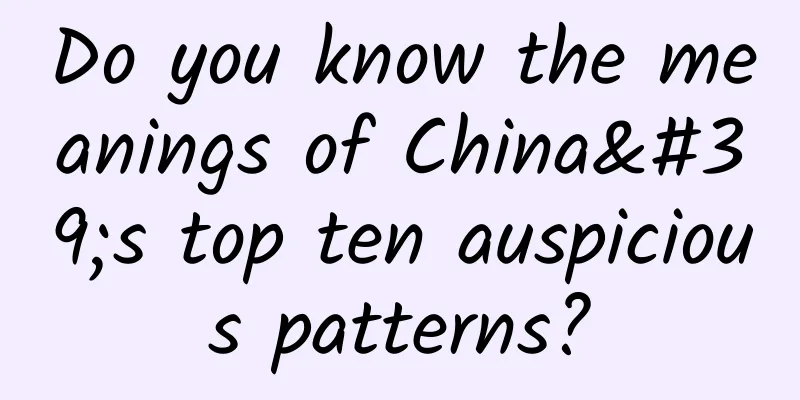Do you know the meanings of China's top ten auspicious patterns?

|
The ten auspicious patterns in ancient China generally include embroidered ball, peace and prosperity, three yangs, boy holding carp, harmony and unity, happiness from heaven, a house full of gold and jade, good luck in the room, five blessings and longevity, and continuous success in the imperial examinations. These auspicious patterns all express people's wishes for a better life. Let's explain the meaning of these auspicious patterns: 1 Hydrangea In ancient times, hydrangeas were considered auspicious and festive. In the Han Dynasty, there was an activity called lion dance with hydrangeas. According to the "Book of Han: Rites and Music", lion dance was popular among the people in the Han Dynasty. Two people acted as a lion, and one person held a colorful ball to amuse the lion. They jumped up and down, which was lively and interesting. In this way, it is roughly the same as modern lion dance. The pattern of "lion dance with hydrangeas" is also called "hydrangea brocade" or "hydrangea pattern", which means to ward off disasters and pray for blessings. 2 Peaceful Elephants Elephants have been regarded as auspicious animals since ancient times. They are heavy and steady, and can carry a treasure bottle. The treasure bottle refers to the legendary water purification bottle of Guanyin, which contains holy water and can bring good luck when sprinkled. "Ping" is also homophonic to "peaceful" in "peaceful", so there are sayings such as "peaceful elephants" and "happy elephants bring peace", which means peace in the world and prosperity for the people. 3 Three Yang Kaitai The pattern of San Yang Kai Tai is three sheep. The word "sheep" in ancient times is the same as "auspicious", which means auspiciousness. "Three sheep" is homophonic to "three yangs". Tai hexagram is Qian below and Kun above, and the first to third lines are three yang lines, so it is said "San Yang Kai Tai". Tai hexagram means that heaven and earth are connected and all things are connected, and "San Yang Kai Tai" means that auspiciousness and good luck follow one after another. 4 Boy holding carp In the picture of a boy holding a carp, the word "fish" in carp has the same pronunciation as "surplus", which means a rich life and a prosperous family during the New Year. Every New Year, every household likes to hang a New Year picture of a boy holding a carp, which not only expresses the joy of celebration but also hopes for good luck in the coming year. 5 The Two Immortals of Harmony and Unity The Two Immortals of Harmony and Unity refer to the two eminent monks Hanshan and Shitou, symbolizing a harmonious family and a happy marriage. In ancient times, people would usually hang up pictures of harmony and unity during weddings, in the hope of a happy and harmonious marriage. 6 Good news from heaven In ancient times, spiders were called "happy spiders". There is a record in Lu Ji's "Shi Shu": "It is also called long-legged. People in Henei, Jingzhou call it the mother of joy. If this insect comes to wear people's clothes, it means that close guests are coming and there is joy." Therefore, people believe that spiders are a symbol of good luck, and the fall of a happy spider means "joy from the sky." 7. A House Full of Gold and Jade The pattern of "Jin Yu Man Tang" is golden fish filling the pond (golden fish full pond). "Fish" is homophonic to "jade", and "pond" is homophonic to "hall". Fish have been regarded as auspicious things since ancient times, and golden fish are more noble and auspicious. "Jin Yu Man Tang" means abundant wealth. 8. Good Luck This pattern is a chicken standing on a stone. “Chicken” is a homophone for “good luck” and “stone” is a homophone for “room”. “Good luck on the room” means the health and good fortune of the whole family. 9 Five Blessings for Longevity The pattern of Five Blessings Holding Longevity is five bats surrounding a Chinese character for longevity. “Fu” in bat is a homophone of “Fu”, and “Five Blessings” is explained in Book of Documents: Hong Fan as “Five Blessings: one is longevity, two is wealth, three is health and peace, four is good virtue, and five is a good fortune.” The meaning of Five Blessings Holding Longevity is good fortune and longevity. 10 Xidelianko The pattern of "Xi De Lian Ke" includes magpie, lotus and reed. In folk legends, magpie is a bird that can announce good news. "Lotus" and "lian" are homophones of each other. Reeds are connected to each other, so "lian ke" is homophone of "lianke". The patterns together form the auspicious pattern of "Xi De Lian Ke", which means that students will get good grades in exams one after another. |
>>: This disease cannot be inherited from parents, they look basically the same! Just because...
Recommend
Entering the active stage! Once infected, it is likely to be life-threatening
Mr. Gao's hometown is in the mountainous area...
Lunar Module: The two richest men in the world compete on the lunar surface
On May 19, 2023, NASA announced that it had selec...
2021 Beauty and Skin Care Marketing Strategy
This may be the most comprehensive beauty and ski...
What does SNS promotion mean? How to do SNS promotion?
In the past few days, we have been introducing se...
How to build a user portrait that can be implemented?
01Written in front User portrait is a commonplace...
Electric Technology Car News: Can the younger and more alternative Dongfeng Fengshen, inspired by cats, lead the trend in the hardcore SUV trend?
In today's automobile trend, the appearance o...
Will scaling crack your teeth? The more you scale, the more problems you’ll have? Be sure to read these myths before scaling!
Teeth cleaning has become more and more popular i...
As a market operator, you must know the Internet operation and promotion channels!
I believe that this may be the most comprehensive...
Volvo abandons merger with Geely and will seek independent listing
The previous merger plan of China's Geely Aut...
7 B2B content marketing trends for 2019!
With its unparalleled efficiency and considerable...
China's space industry is 67 years old today! Today, we will show you how to look at space industry from a different perspective
On October 8, 1956, the Fifth Academy of the Mini...
Data is here丨A study on the consumption behavior of Douyin and Kuaishou users during the Spring Festival
During the epidemic, for friends who stay at home...
Summary of high-quality marketing channels for APP promotion!
In recent years, the frequency of use of mobile a...
Apple will release Swift 3.0 and announce the development content of the fourth version
Although the official version of Swift 3.0 will b...
Smart launches 2017 electric car that can be fully charged in 2.5 hours
The popularity of driverless cars and electric ca...









